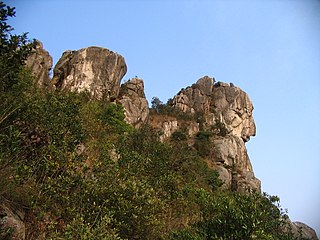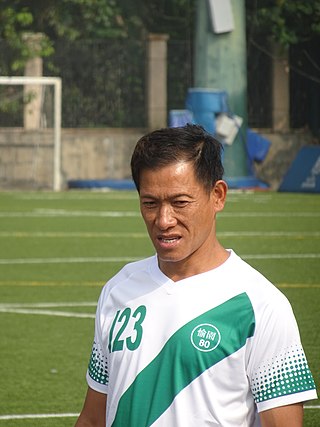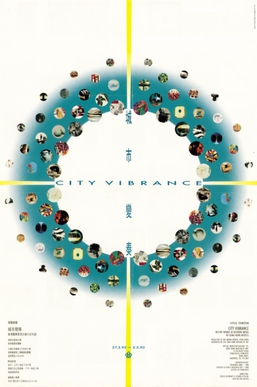
Lion Rock, or less formally Lion Rock Hill, is a mountain in Hong Kong. It is located in Sha Tin District, between Kowloon Tong of Kowloon and Tai Wai of the New Territories, and is 495 metres (1,624 ft) high. The peak consists of granite covered sparsely by shrubs. The Kowloon granite, which includes Lion Rock, is estimated to be around 140 million years old.

Shatin Pui Ying College, abbreviated as SPYC or PYC, is a Christian school that was established in 1978. Located in Hong Kong, SPYC is an English medium of instruction (EMI) secondary school fully subsidised by the government with 4 classes each for Forms 1 to 5 and 5 classes for Form 6. The school icon is an eagle symbolising courage and determination.

Shum Kwok Pui is a former Hong Kong professional footballer who played as a centre back.
Simon Peh Yun-lu was Director of Immigration of Hong Kong, and was appointed Commissioner of the Independent Commission Against Corruption in 2012.

Loo Hor-kuay, also known as George Hughko Lo, was a basketball player who played as a center.

Red-white-blue bag or laundry bag is a carriage bag made out of nylon canvas in colors of red, white and blue. It originated in Hong Kong in the 1960s and has become a representative of Hong Kong culture. Because the nylon canvas is known of its light, firmness and durable usage, it is commonly used as hand carry luggage and transport between Mainland China and Hong Kong.

Kacey Wong is a Hong Kong visual artist and educator – formerly Assistant Professor at the School of Design, Hong Kong Polytechnic University. Wong has received the Hong Kong Contemporary Arts Award by the Hong Kong Art Museum (2012), Best Artist Award (2010); and Rising Artist Award and Outstanding Arts Education Award (2003). Wong is politically engaged through his art, and is founding member of art-activist groups Art Citizens and the Umbrella Movement Art Preservation.
Pang Chai-sip was a renowned Hong Kong artist of the Lingnan school of Chinese painting. Born in Guangdong, Pang started his life in art as a student at the Art Institute of Guangzhou (廣州市立美術學院), by which he learnt his painting skills and philosophy with virtuosos in the field like Li Yanshan, Li Jinfa, Chao Shao-an, Huang Junbi and Li Xiongcai.

West Buffalo Hill or Wong Ngau Shan (黃牛山) is a 604-metre-high (1982-ft) hill within Ma On Shan Country Park, New Territories, Hong Kong. It lies directly west of Buffalo Hill, thus receiving its name. Stage 4 of the MacLehose Trail passes through the hill.

Liu Pui Fung is a former Hong Kong professional footballer who played as a Right winger.

The yellow economic circle, also known as the yellow economy, is a form of consumer activism in Hong Kong, in which businesses are classified based on their support or opposition to the 2019–2020 protests in the city. It was created by protesters to enable dollar voting and support like-minded businesses, sustain the livelihoods of pro-democracy business owners, create job opportunities for supporters of the movement, and reduce local dependence on businesses that are connected to the Chinese Communist Party. Local political analysts suggested that the yellow economic circle could have increased votes for the pro-democracy camp in the Catering, Wholesale, and Retail functional constituency in the later postponed 2020 legislative election.
Wong Ho-wa is a Hong Kong data scientist and pro-democracy activist. He led the open government data community g0vhk from 2016 to 2021. He was an Election Committee member representing the information technology (IT) industry from 2016 to 2021 and ran for the Information Technology constituency in the 2020 Hong Kong legislative election as part of the pro-democratic caucus.
The written traditional Chinese characters for vertical banners are "直幡", and the horizontal counterpart, horizontal banners are written as "横額" in traditional Chinese.

City Vibrance: Recent Works in Western Media by Hong Kong Artists was an art exhibition held at the Hong Kong Museum of Art from 27 March to 2 May 1992. It showcased the work of a broad cross-section of contemporary Hong Kong artists using a wide range of art media.
The Nine Alliances of Lek Yuen or Kau Yeuk was a regional organization of various groups in Sha Tin Valley, Hong Kong.

Hong Kong people of Fujianese origin. Also known as Hoklo. North Point has a prominent Fujianese community. During the Hong Kong protests there were rumors of armed gangs from the mainland coming to settle disputes with protesters.










